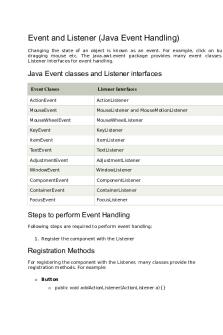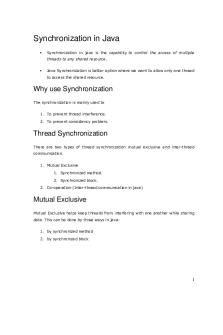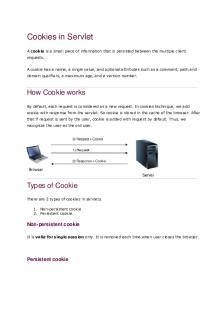Event Handling IN JAVA PDF

| Title | Event Handling IN JAVA |
|---|---|
| Course | Btech |
| Institution | APJ Abdul Kalam Technological University |
| Pages | 6 |
| File Size | 155.1 KB |
| File Type | |
| Total Downloads | 77 |
| Total Views | 146 |
Summary
NOTES ON EVENT HANDLING IN JAVA WITH DEATILED DESCRIPTION....
Description
Event and Listener (Java Event Handling) Changing the state of an object is known as an event. For example, click on bu dragging mouse etc. The java.awt.event package provides many event classes Listener interfaces for event handling.
Java Event classes and Listener interfaces Event Classes
Listener Interfaces
ActionEvent
ActionListener
MouseEvent
MouseListener and MouseMotionListener
MouseWheelEvent
MouseWheelListener
KeyEvent
KeyListener
ItemEvent
ItemListener
TextEvent
TextListener
AdjustmentEvent
AdjustmentListener
WindowEvent
WindowListener
ComponentEvent
ComponentListener
ContainerEvent
ContainerListener
FocusEvent
FocusListener
Steps to perform Event Handling Following steps are required to perform event handling: 1. Register the component with the Listener
Registration Methods For registering the component with the Listener, many classes provide the registration methods. For example: o Button o public void addActionListener(ActionListener a){}
o MenuItem o public void addActionListener(ActionListener a){} o TextField o public void addActionListener(ActionListener a){} o public void addTextListener(TextListener a){} o TextArea o public void addTextListener(TextListener a){} o Checkbox o public void addItemListener(ItemListener a){} o Choice o public void addItemListener(ItemListener a){} o List o public void addActionListener(ActionListener a){} o public void addItemListener(ItemListener a){}
Java Event Handling Code We can put the event handling code into one of the following places: 1. Within class 2. Other class 3. Anonymous class
Java event handling by implementing ActionListener 1.
import java.awt.*;
2. 3.
import java.awt.event.*; class AEvent extends Frame implements ActionListener{
4.
TextField tf;
5.
AEvent(){
6. 7.
//create components
8.
tf=new TextField();
9.
tf.setBounds(60,50,170,20);
10. 11.
Button b=new Button("click me"); b.setBounds(100,120,80,30);
12. 13.
//register listener
14. 15.
b.addActionListener(this);//passing current instance
16.
//add components and set size, layout and visibility
17.
add(b);add(tf);
18.
setSize(300,300);
19.
setLayout(null);
20.
setVisible(true);
21.
}
22.
public void actionPerformed(ActionEvent e){
23.
tf.setText("Welcome");
24.
}
25.
public static void main(String args[]){
26. 27.
new AEvent(); }
28.
}
public void setBounds(int xaxis, int yaxis, int width, int height); have been used in the above example that sets the position of the component it may be button, textfield etc.
2) Java event handling by outer class 1.
import java.awt.*;
2.
import java.awt.event.*;
3.
class AEvent2 extends Frame{
4. 5.
TextField tf; AEvent2(){
6.
//create components
7.
tf=new TextField();
8. 9.
tf.setBounds(60,50,170,20); Button b=new Button("click me");
10.
b.setBounds(100,120,80,30);
11.
//register listener
12.
Outer o=new Outer(this);
13.
b.addActionListener(o);//passing outer class instance
14.
//add components and set size, layout and visibility
15.
add(b);add(tf);
16. 17.
setSize(300,300); setLayout(null);
18.
setVisible(true);
19. 20.
} public static void main(String args[]){
21.
new AEvent2();
22.
}
23.
}
1.
import java.awt.event.*;
2.
class Outer implements ActionListener{
3.
AEvent2 obj;
4. 5.
Outer(AEvent2 obj){ this.obj=obj;
6.
}
7.
public void actionPerformed(ActionEvent e){
8. 9.
obj.tf.setText("welcome"); }
10.
}
3) Java event handling by anonymous class 1. 2.
import java.awt.*; import java.awt.event.*;
3.
class AEvent3 extends Frame{
4.
TextField tf;
5. 6.
AEvent3(){ tf=new TextField();
7.
tf.setBounds(60,50,170,20);
8.
Button b=new Button("click me");
9.
b.setBounds(50,120,80,30);
10. 11.
b.addActionListener(new ActionListener(){
12.
public void actionPerformed(){
13. 14.
tf.setText("hello"); }
15.
});
16.
add(b);add(tf);
17. 18.
setSize(300,300); setLayout(null);
19.
setVisible(true);
20.
}
21.
public static void main(String args[]){
22.
new AEvent3();
23. 24.
} }...
Similar Free PDFs

Event Handling IN JAVA
- 6 Pages

Java Event Driven Programming:
- 14 Pages

Loopsin Java - Loops in Java
- 9 Pages

Current event 1.24 (in)
- 1 Pages

Event
- 4 Pages

Synchronization in Java
- 11 Pages

Multithreading in Java
- 12 Pages

Access Specifiers in Java
- 4 Pages

Programmazione in Java Script
- 177 Pages

Handling solutions
- 31 Pages

Klassen und Objekte in Java
- 5 Pages
Popular Institutions
- Tinajero National High School - Annex
- Politeknik Caltex Riau
- Yokohama City University
- SGT University
- University of Al-Qadisiyah
- Divine Word College of Vigan
- Techniek College Rotterdam
- Universidade de Santiago
- Universiti Teknologi MARA Cawangan Johor Kampus Pasir Gudang
- Poltekkes Kemenkes Yogyakarta
- Baguio City National High School
- Colegio san marcos
- preparatoria uno
- Centro de Bachillerato Tecnológico Industrial y de Servicios No. 107
- Dalian Maritime University
- Quang Trung Secondary School
- Colegio Tecnológico en Informática
- Corporación Regional de Educación Superior
- Grupo CEDVA
- Dar Al Uloom University
- Centro de Estudios Preuniversitarios de la Universidad Nacional de Ingeniería
- 上智大学
- Aakash International School, Nuna Majara
- San Felipe Neri Catholic School
- Kang Chiao International School - New Taipei City
- Misamis Occidental National High School
- Institución Educativa Escuela Normal Juan Ladrilleros
- Kolehiyo ng Pantukan
- Batanes State College
- Instituto Continental
- Sekolah Menengah Kejuruan Kesehatan Kaltara (Tarakan)
- Colegio de La Inmaculada Concepcion - Cebu




